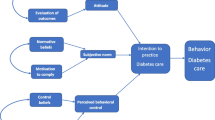Abstract
Purpose. Study purpose was to develop a theoretical framework that will explain pharmacists' behavior relative to the provision of pharmaceutical care. The model was developed from four attitude models by testing their predictive validity relative to pharmaceutical care implementation. Four hypotheses and one research question were investigated to identify determinants of behavioral intention and behavior.
Methods. 617 community pharmacists in the state of Florida, U.S.A., were surveyed twice using mail survey methodology to collect data. The first survey assessed community pharmacists' attitude, subjective norm, perceived behavioral control, past behavior recency, self-efficacies, instrumental beliefs and affect. The second survey assessed pharmacists' behavior relative to the implementation of pharmaceutical care. After establishing reliability and validity of measures, regression analysis was used to test hypotheses and research question investigated.
Results. The Pharmacists' Implementation of Pharmaceutical Care (PIPC) model developed postulates that (i) behavior is directly determined by past behavior recency, behavioral intention and perceived behavioral control; (ii) psychological appraisal processes— instrumental beliefs, self-efficacies, and affect toward means— influence behavior through past behavior recency; and (iii) behavioral intention is determined by attitude, social norm and perceived behavioral control.
Conclusions. The PIPC model provides a formal scientifically validated theoretical framework which can be used to design successful intervention for pharmaceutical care implementation.
Similar content being viewed by others
REFERENCES
C. D. Hepler, & L. M., Strand. Am J Hosp Pharm. 47:533–543 (1990).
R. P. Penna. Am J Hosp Pharm. 47:543–549 (1990).
I. Ajzen. In J. Kuhl & J. Beckman (Eds.), Action control: From cognition to behavior, Herdelberg: Springer-Verlag, 1985, pp. 11–39.
R. P. Bagozzi, and P. R. Warshaw. J Consum Res. 17:127–140 (1990).
I. Ajzen. Attitudes, personality, and behavior. Chicago: Dorsey Press, (1988).
M. Fishbein & I. Ajzen. Belief, attitude, intention, and behavior: An introduction to theory and research. Massachusetts: Addison-Wesley, (1975).
I. Ajzen & M. Fishbein. Psych Bull. 84:888–918 (1977).
I. Ajzen & M. Fishbein. Understanding attitudes and predicting social behavior. Englewood-Cliffs, NJ: Prentice-Hall, 1980.
R. P. Bagozzi., H. Baumgartner, & Y. Yi. Psych Market. 9:469–486, (1992).
R. P. Bagozzi, and P. R. Warshaw. Multivar Behav Res. 27:601–634 (1992).
R. P. Bagozzi. Soc Psych Quart. 55:178–204 (1992).
D. A. Beale & A. S. R. Manstead. J App Soc Psychol. 21:409–431 (1991).
R. G. Netemeyer & S. Burton. J App Soc Psychol. 20:661–680 (1990).
I. Ajzen & T. J. Madden. J Exp Soc Psychol. 22:453–474 (1986).
R. P. Bagozzi, F. D. Davis, & P. R. Warshaw. Hum Relat. 45:659–686 (1992).
F. T. Badejogbin & C. D. Hepler. Predicting the provision of pharmaceutical care in community pharmacies. Podium session pressented at the annual meeting of the American Pharmaceutical Association, Seattle, Washington (1994, March).
R. P. Bagozzi. Psych and Market. 10:215–237 (1993).
F. T. Odedina, & R. Segal. Am J Health-Syst Pharm. 53:855–865 (1996).
J. P. Robinson, P. R. Shaver, & L. S. Wrightsman. In J. P. Robinson, P. R. Shaver, P. R. & L. S. Wrightsman (Eds), Measures in personality and social psychological attitudes. California: The Academic Press 1991, pp. 1–15.
K. G. Joreskog & D. Sorbom. LISREL VI: Analysis of linear structural relationships by maximum likelihood, instrumental variables, and least square methods. Indiana: Scientific Software 1986.
D. A. Belsey, E. Kuh & R. E. Welsch. Regression Diagnostics. New York: John Wiley and Sons 1980.
I. Ajzen. T.Organ Behav Hum Decis Process. 50:179–211 (1991).
J. Cohen. Statistical power analysis for behavioral science. New York: Academic Press 1977.
F. E. Crawley III. J Res Sci Teach. 27:685–697 (1990).
R. J. Lutz. J Consum Res. 1:49–59 (1975).
Rights and permissions
About this article
Cite this article
Odedina, F.T., Hepler, C.D., Segal, R. et al. The Pharmacists' Implementation of Pharmaceutical Care (PIPC) Model. Pharm Res 14, 135–144 (1997). https://doi.org/10.1023/A:1012032223328
Issue Date:
DOI: https://doi.org/10.1023/A:1012032223328




